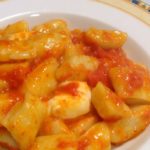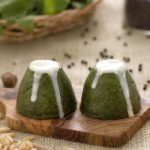POTATO GNOCCHI, A GIFT FROM AMERICAS

Potato gnocchi recipe is relatively recent in the Italian tradition, compared to the other ones.
Gnocchi is spread in all regions of Italy, and with all possible ingredients, depending on where it comes from: flour, corn, semolina, bread, chestnut flour, ricotta, or vegetables – from squash to spinach to classic potato.
The potato was discovered by chance by the conquistadores of Spain, who rode over the tubers in pursuit of the Inca leader, Atahualpa, and his riches. They almost literally “stumbled upon” this precious tuber in the first decades of 15th century.
The story of the conquest by the humble potato of the rest of the world was slow and full of misunderstandings, particularly in Italy. Imported from Spain, it appeared in botanical gardens of Padua and Verona as a scientific “curiosity” in 1591 and 1608. In 1565, King Philip II had gifted the Vatican court with some sample of tubers which were mistaken for truffles, and of course, used improperly. This episode and some other related to food poisoning (potatoes can develop toxicity in certain conditions), prevented a fast growth of its popularity.
While other countries realized the nutritious potential and resiliency in conditions often hostile to the cultivation of cereals, in Italy, the extensive cultivation of potatoes appeared only in the second half of the 19th century. Probably the political divisions of Italy in so many small kingdoms prevented modern agricultural development.
POTATO GNOCCHI
- 2,5 pounds (1 kg) white, russet or other starchy potatoes, steamed and peeled
- 1 + 1/4 cups (300 gr.) “00” flour, plus more as needed
- 1 large egg
- Push the potatoes (while still tepid/warm) through a food mill or potato ricer, onto a lightly floured work surface. In case the potatoes are too humid (moist) bake them for 5 minutes in the oven, before mashing them.

- Gather the potatoes into a mound and make a well in the center. Sprinkle ¾ of the flour into the well and add in the egg. Mix the ingredients by hand until a soft dough forms. If necessary, add more flour, a little at a time, until the dough has a smooth, evenly moistened consistency.

- Lightly flour your work surface and divide the dough into at least eight portions. Roll the portions into 1-inch-thick ropes and cut the ropes into 1-inch pieces. Roll the gnocchi over a fork to shape them, if desired.

- Bring a large pot of salted water to a boil. Add the gnocchi and stir a few times with a wooden spoon to submerge and separate them. Cook at a gentle boil until the gnocchi are tender and just beginning to float, about 2 to 3 minutes. Drain the gnocchi and serve with the sauce.
Gnocchi must be eaten within 2 hours from their preparation or frozen on a paper tray covered by parchment lightly sprinkled with flour. They must be carefully separated so that they do not stick together. After 3-4 hours they can be put in a bag. NEVER THAW frozen pasta, just boil it as it is, just add 2-3 minutes to the cooking time.







